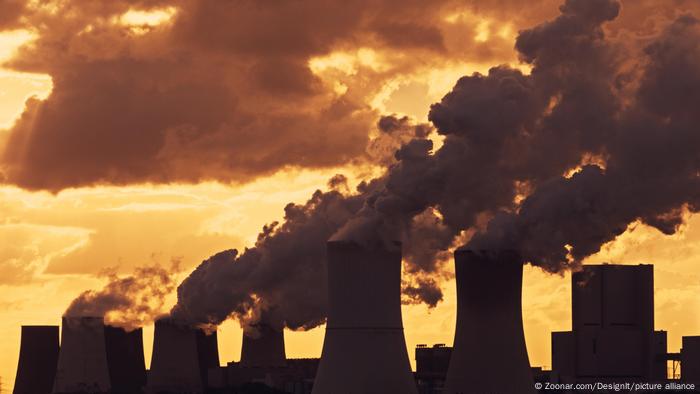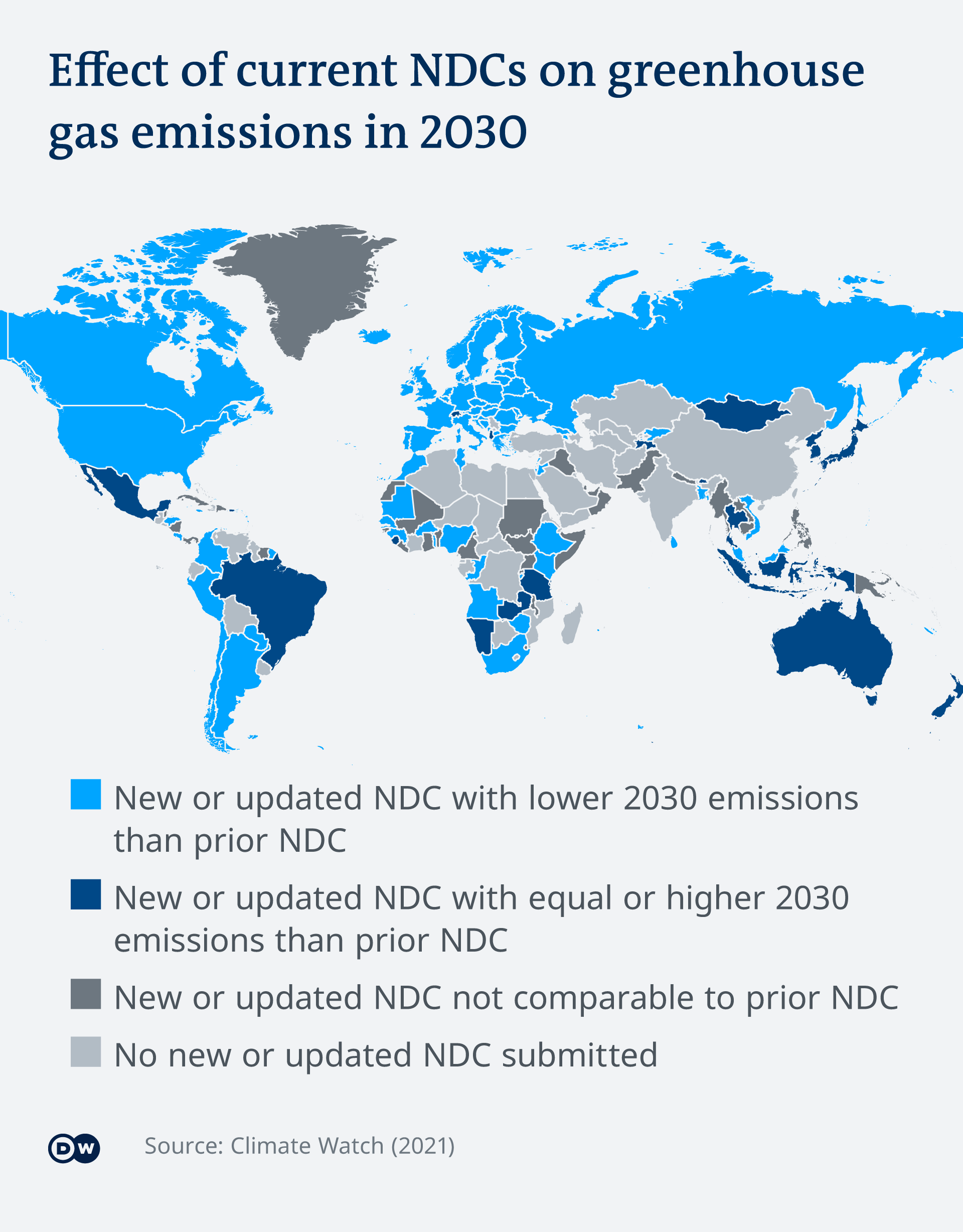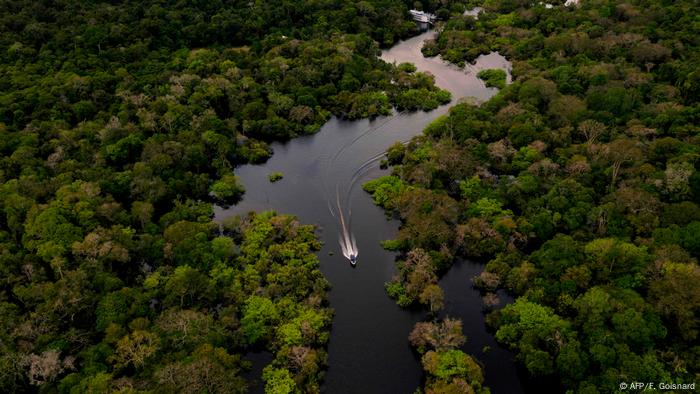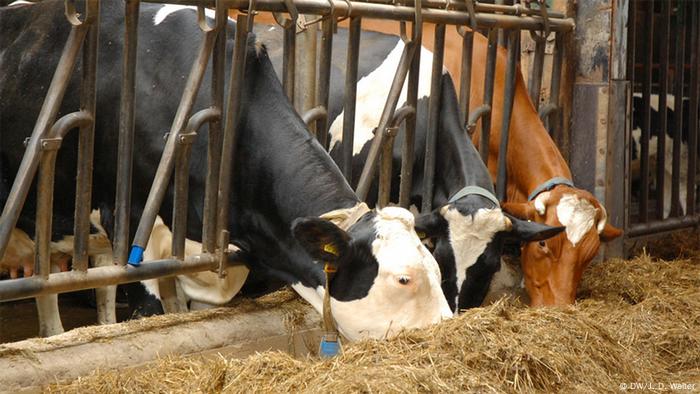The UN's latest Emissions Gap Report shows that the world is on track for a temperature rise of 2.7 degrees Celsius this century. Ahead of next week's COP26 climate summit, it said nations must act urgently.

"The heat is on" is the title of the new Emissions Gap Report published on Tuesday by the United Nations Environment Program (UNEP). The report analyzes the updated national climate plans — known as nationally determined contributions (NDCs) — of 120 countries.
The NDCs are at the core of the Paris Climate Agreement. All signatories are required to set national climate targets and regularly report on both their implementation and new targets.
The name of the UNEP's latest report says it all — and its findings are sobering. With the updated NDCs, greenhouse gas emissions will only see a reduction of 7.5% by 2030. But in order to achieve the goal of the Paris Agreement and limit global warming to 1.5 degrees Celsius/2.7 degrees Fahrenheit (compared to 1900 levels), greenhouse gases would have to fall by 55%.
'The clock is ticking loudly'
In other words, the world must cut its emissions by 28 gigatons of CO2 equivalent (GtCO2e) per year by 2030. To limit emissions to 2 C, countries would still have to reduce their climate-damaging emissions by 30%, or 13 GtCO2e.
"To be clear: we have eight years to make the plans, put in place the policies, implement them and ultimately deliver the cuts. The clock is ticking loudly," Inger Andersen, executive director of the UNEP, wrote in the report.
If, however, countries just stick to their own national climate targets, which they are allowed to set individually under the Paris Agreement, the world is on track for a temperature rise of 2.7 C.
"That would result in catastrophic climate change that we would not be able to cope with at all — that must be avoided at all costs," said Niklas Höhne, director of the Cologne-based nonprofit research organization New Climate Institute and professor of climate protection at Wageningen University in the Netherlands.

Pandemic was a missed opportunity
The UNEP report expressed disappointment that investments designed to stimulate the economy after the coronavirus pandemic had barely taken climate protection into consideration. According to the report, less than one-fifth of recovery packages are likely to contribute to a reduction in greenhouse gas emissions.
In 2020, the COVID-19 pandemic led to a 5.4% drop in new emissions worldwide. At the same time, the concentration of greenhouse gases in the atmosphere reached a new high, according to a report from the World Meteorological Organization, the UN's weather and climate agency.
Compared to the previous year, the increase was even higher than the average rise over the past decade, the report said. Or, as the UNEP puts it: "CO2 concentrations are higher than at any time in the last 2 million years."

Natural greenhouse gas sinks, like the Amazon, can help offset emissions
Net-zero targets bring hope
According to the UNEP, the net-zero pledges made by a host of countries, including the United States, Japan, China, as well as the European Union, could make a significant difference.
Net zero means that for all of the greenhouse gas emissions caused by humans, the same amount must be removed from the atmosphere. Artificial and natural greenhouse gas sinks, such as peatlands or forests, can be offset against greenhouse gases emitted.
"If made robust and implemented fully, net-zero targets could shave an extra 0.5 C off global warming, bringing the predicted temperature rise down to 2.2 C," the UNEP report says. It is critical, however, of the fact that many countries are not planning to start working toward net-zero until after 2030.
An extreme world — even with a 2 C increase
Countries need to link long-term net-zero targets to their ongoing NDCs and move forward quickly, UNEP Executive Director Andersen urged in the report's foreword. "This can't happen in five years. Or in three years. This needs to start happening now," she said.
Even if global warming were stopped at 2 C, Niklas Höhne of the New Climate Institute said the world would be a changed place. "We are currently at a temperature increase of 1 C. And we're seeing droughts, forest dying, floods — like in [Germany's] Ahr Valley — and fires all over the world. An increase of 2 C means, as a first approximation, twice as many floods, twice as many extreme weather events."

Livestock farming is just one of the ways methane is released into the atmosphere
Potential in methane, carbon markets
The UNEP report sees another opportunity to close the gap between climate targets and the current reality, through the reduction of methane emissions.
Methane not only escapes during the extraction of fossil fuels, but is produced during the decomposition of organic waste, in the treatment of wastewater and through livestock farming and rice cultivation.
Though methane only lingers in the atmosphere for 12 years compared to up to centuries for CO2, it is much more potent and therefore significantly more harmful to the climate during its relatively short lifespan. As such, a rapid reduction of methane emissions could limit temperature rise faster in the short term than a drop in CO2, according to the report.
Mechanisms such as compensation payments to poorer countries or clearly defined and properly designed carbon markets could also lead to countries taking more ambitious climate protection measures, the UNEP authors wrote.
"We are so late to climate action that it is imperative that developed countries, in addition to efforts at home, help developing countries reduce emissions as quickly as possible. The emissions gap is so large that no country can sit back," Höhne said.
This year's Emissions Gap Report highlights not only failures but also the enormous potential for more climate action, wrote UNEP's Andersen. For example, policies implemented between 2010 and 2021 will lower annual emissions by 11 GtCO2e in 2030 compared to what would have happened without them.
Though she said "we should not despair," she also called on the world to "wake up to the imminent peril we face as a species. We need to go firm. We need to go fast. And we need to start doing it now."
This article has been adapted from German
Rob Waugh
·Contributor
Tue, 26 October 2021
China is by the far the biggest overall emitter of greenhouse gases. (Getty Images)
At this year’s United Nations COP26 climate conference, attempts to limit greenhouse gas emissions will be centre-stage.
Carbon dioxide and other greenhouse gases such as methane cause heat to become trapped in Earth’s atmosphere, leading to a warming effect.
Levels of carbon dioxide in our atmosphere are more than 50% higher than before the Industrial Revolution, according to statistics from the Met Office.
In 2020, the global average temperature stood at 1.2C above pre-industrial levels, according to the World Meteorological Organisation’s State of the Global Climate 2020 report.
This year is the deadline for the 191 countries that signed up to the Paris Agreement in 2015 to agree to steeper emissions cuts known as nationally determined contributions.
To achieve the Paris Agreement’s goal of limiting global temperature rise to 1.5C, carbon emissions must be halved by 2030.
Read more: A 1988 warning about climate change was mostly right
The 1.5C figure is considered important, because above that level of rise, there will be more heatwaves, extreme weather events and droughts – leading to economic losses, forced migration and loss of human life.
Total greenhouse gas emissions per year (Our World in Data/World Research Institute)
Carbon dioxide accounts for roughly 76% of carbon emissions, followed by methane (mostly from agriculture) at 16%, according to America’s Environmental Protection Agency.
But CO2 emissions vary widely by country, as well as by industry, with 60% of global CO2 emissions coming from the power and industry sector, according to the UN’s Intergovernmental Panel on Climate Change.
Which countries emit the most greenhouse gases?
China emitted 11.58 billion tonnes of CO2 in 2016, compared to the US's 5.83 billion tonnes, according to data from Our World in Data and the World Resources Institute.
India emitted 3.24 billion tonnes, and Russia emitted 2.39 billion tonnes (see chart below).
Gas emissions by country in 2016 (Our World in Data/World Research Institute)
China is by far the world’s biggest contributor to greenhouse gas levels, emitting more than the entire developed world combined in 2019, according to research by Rhodium Group.
President Xi Jinping is not likely to attend the COP26 talks, Chinese officials have warned Boris Johnson.
The Chinese leader is not thought to have left China since March 2020: instead, China’s special envoy on climate change Xie Zhenhua will be in attendance.
This poses a problem at the COP26 conference: China, India, Saudi Arabia and Turkey, which are together responsible for around a third of global emissions, have not yet come forward with new emissions goals.
Which countries emit the most greenhouse gas per capita?
While China, which has the world’s largest population, is the biggest overall emitter, it is not in the top 10 countries with the highest emissions per capita.
The world’s largest per capita CO2 emitters tend to be major oil-producing countries, particularly those with small populations such as Qatar and Kuwait.
Guyana has become the world’s greatest per capita emitter after the discovery of a major offshore oil and gas field.
Greenhouse gas emission by country per capita (Our World in Data)
Guyana's petroleum development is just beginning, although politicians in the country claim the revenue from the oil will help investment in renewable and alternative energy sources.
In terms of total carbon emitted over time, China is in second place to the US, according to research by Carbon Brief.
Carbon Brief’s analysis of total carbon emissions by countries around the world since 1850 shows that the US is the biggest polluter in history, with China close behind.
The UK ranks in eighth place.
Carbon Brief found that humans have pumped a total around 2,500 billion tonnes of CO2 into the atmosphere since 1850 (taking into account both industrial emissions and emissions due to changes in land use) – with the US responsible for 20% of this total.
Which industries emit the most carbon dioxide?
Three-quarters of greenhouse gas emissions come from the energy sector (including energy for transport, heating buildings and use in industry), according to statistics from Our World in Data and the World Resources Institute.
Transport represents 16.2% of greenhouse gas emissions, with 1.9% from the aviation sector alone, mostly in the form of CO2.
Greenhouse gas emissions by sector (Our World in Data/World Research Institute)
In agriculture (responsible for 18.4% of global emissions), 4.1% of total global emissions comes from agricultural soils, where nitrous oxide (a greenhouse gas) is emitted when nitrogen fertilisers are applied to soils.
Another 5.8% of the global total comes from livestock and manure, from animals such as cattle and sheep that produce large amounts of methane as they digest grass.
By FRANK JORDANS

In this long time exposure photo, trucks and cars roll on a highway in Frankfurt, Germany, Tuesday, Oct. 26, 2021. (AP Photo/Michael Probst)
BERLIN (AP) — The head of the United Nations says a “leadership gap” is undermining the world’s efforts to curb global warming, days before presidents and prime ministers from around the globe gather for a climate summit in Glasgow, Scotland.
U.N. Secretary-General Antonio Guterres told reporters Tuesday that time is running out to cut greenhouse gas emissions and meet the goals of the 2015 Paris accord to avert global warming that he said could become “an existential threat to humanity.”
“The clock is ticking,” he said in New York at the presentation of a U.N. report highlighting the difference between what scientists say is needed and what countries are doing to reduce the amount of greenhouse gas being pumped into the atmosphere. “This is a moment of truth.”
“The emissions gap is the result of a leadership gap,” Guterres said. “But leaders can still make this a turning point to a greener future instead of a tipping point to climate catastrophe. ”
The new report by the U.N. Environment Programme found fresh pledges by governments to cut emissions are raising hopes but aren’t strict enough to keep global warming from exceeding 1.5 degrees Celsius (2.7 degrees Fahrenheit) by the end of the century.
It concluded that recent announcements by dozens of countries to aim for “net-zero” emissions by 2050 could, if fully implemented, limit a global temperature rise to 2.2 degrees Celsius (4 F). That’s closer but still above the less stringent target agreed upon in the Paris climate accord of capping global warming at 2 degrees Celsius (3.6 F) compared to pre-industrial times.
“Every ton of carbon dioxide emissions adds to global warming,” French climate scientist Valerie Masson-Delmotte, who co-chaired an August U.N. climate science report, told the United Nations on Tuesday. “The climate we experience in the future depends on our decisions now.”
The European Union, the United States and dozens of other countries have set net-zero emissions targets. However, the UNEP report said the net-zero goals that many governments announced ahead of a U.N. climate summit in Glasgow next week remain vague, with much of the heavy lifting on emissions cuts pushed beyond 2030.
Guterres said scientists were clear on the facts of climate change, adding that “now, leaders need to be just as clear in their actions.”
“They need to come to Glasgow with bold, time-bound, front-loaded plans to reach net zero,” he said.
Guterres made a direct plea to China, the top carbon polluter, to make carbon-cutting efforts go faster than previously proposed because “that would have an influence on several other countries.” China hasn’t updated its required emissions cut pledge.
The report came out as the U.N. General Assembly focused on climate change in a marathon session of speeches Tuesday. The presidents of vulnerable island nations Palau and the Maldives used the opportunity to plea for the world to do more because their countries are at risk of being wiped out.
“Our homes, our blue economy, our heath and our overall well-being have been ravaged by the climate crisis,” Palau President Surangel Whipps Jr. told the General Assembly. “We must take radical action now.”
“The fate of small islands today is the fate of the world tomorrow,” Maldives President Ibrahim Solih said.
Australia became the latest country to announce a net-zero target on Tuesday, but experts swiftly pointed out that it doesn’t stack up.
The U.N. Environment Programme is one of several agencies to examine the gap between government pledges and the Paris goals. Its executive director echoed the need for speed on curbing emissions.
“To stand a chance of limiting global warming to 1.5 C, we have eight years to almost halve greenhouse gas emissions,” said Inger Andersen. “Eight years to make the plans, put in place the policies, implement them and ultimately deliver the cuts.”
Leaders, diplomats, scientists and environmental activists will meet in Glasgow from Oct. 31-Nov. 12 to discuss how countries and businesses can adjust their targets to avert the more extreme climate change scenarios that would result in a significant sea-level rise, more frequent wild weather and more droughts.
Guterres said he would use a trip to the Group of 20 meeting in Italy to press all countries, including major emerging economies such as China, to do more on climate change.
“If there is no meaningful reduction of emissions in the next decade, we will have lost forever the possibility of reaching 1.5 degrees,” he said.
Guterres said past climate summits had acknowledged that while all countries have to curb emissions, some are more able to do so than others, with leadership coming from the richest and most developed.
“But the level of emissions of the emerging economies is such that we also need the emerging economies to go an extra mile,” he said. “Only if everybody does the maximum, it will be possible to get there.”
The UNEP report emphasized several measures that can help boost efforts to curb global warming, including clamping down on emissions of the potent but short-lived greenhouse gas methane. It also emphasized the need to ensure pandemic recovery funds are spent on environmentally friendly measures.
The report found that most countries have missed the opportunity to use COVID-19 recovery spending to stimulate the economy while backing climate action.
“Despite these alarm bells ringing at fever pitch, we see new evidence today in the (UNEP) Emissions Gap Report that governments’ actions so far simply do not add up to what is so desperately needed,” Guterres told diplomats later Tuesday.
___
Seth Borenstein in Washington, D.C., contributed to this report.
___
Follow AP’s climate coverage at http://apnews.com/hub/climate
Scientists fear global 'cascade' of climate impacts by 2030

Climate hazards such as extreme heat, drought and storms could trigger "cascading impacts" that may be felt around the world within the next decade, warns a study released ahead of the UN climate summit, COP26.
Increasingly frequent extreme weather events could lead to more food insecurity, displacement of people, and conflict within vulnerable countries by 2030, with knock-on effects for whole regions and the global economy, according to the report by UK-based policy institute Chatham House.
The ten "hazard-impact pathways" of greatest near-term concern all relate to Africa or Asia, the report says, referring to the chain of impacts triggered by climate-related events.
However, the repercussions of these hazards may be far-reaching, it suggests.
The research drew on the views of more than 200 climate scientists and other specialists to assess which immediate climate hazards and impacts should most concern decision-makers in the coming decade.
"One of the really concerning things that the research highlighted was that [climate change] impacts aren't confined to the vulnerable place where they happen," said Ruth Townend, a research fellow with the environment and society program at Chatham House and co-author of the report, What near-term climate impacts should worry us the most?
"But the vulnerability of the place where they happen means impacts are bigger than they might otherwise be.
"They then cascade and have knock-on impacts and sort of chain reactions … that are global in their nature, or at least cover large regions."
Adaptation finance
Researchers say the findings, released ahead of COP26 in Glasgow (31 October–12 November), show that it is in the interests of wealthy nations to finance climate adaptation in the most at-risk regions, where action is urgently needed to address socioeconomic vulnerabilities to climate impacts.
Wealthy nations have so far failed to deliver on pledges made at the 2009 climate conference in Copenhagen of at least US$100 billion a year in climate finance to support developing nations in tackling climate change.
"With COP26 coming up, all eyes are focused on … what can be achieved, particularly in terms of cutting emissions, but one of the key findings of the report is that … in the near-term one of the most important things is addressing issues of adaptation," said Townend.
"If we don't act in the 2020s to help vulnerable countries cope with the climate change that is already happening, and will continue to happen, then we're going to incur wildly spiraling costs in terms of dealing with those disasters in the near future."
Concerns highlighted by the climate scientists and other specialists included heightened food insecurity in South and South-East Asia, and Australasia, as well as reduced food security globally arising from multiple climate hazards leading to "breadbasket failures."
"You have these key breadbasket regions which export grain to other areas and they play this really important role of stabilizing food supply," said Townend. "So, if your harvest fails, you're able to buy in grain from outside and that means people don't go hungry and the impacts are confined, but … if those breadbasket regions get hit, that safety net is taken away from the whole region and that can increase global food prices."
Loss and damage
Daniel Quiggin, senior research fellow at Chatham House and lead author of the report, said: "Lack of resilience in the agricultural sector, as well as widespread poverty and inequality in developing nations, most notably in Africa, will exacerbate the impacts of climate change and drive cascading effects across borders.
"Without more aid for adaptation and poverty reduction, food insecurity due to extreme heat, drought, storm damage and multiple crop failures could result in political instability and conflict and drive increased migration to Southern Europe."
The paper calls for the development of a comprehensive climate risk register that charts the communities most vulnerable to climate hazards, the potential cascading risks, and what can be done to increase resilience.
"The key thing that we're saying in this report is that by addressing those issues of vulnerability, we can actually prevent really appalling climate disasters from occurring in this decade," added Townend.
Ritu Bharadwaj, climate governance and finance senior researcher at the International Institute for Environment and Development, said finance for climate 'loss and damage' would be one of the key issues to address at COP26. "It is happening now and vulnerable countries and communities around the world are losing their lives, their livelihoods, their homes—they're getting displaced," she told a SciDev.Net debate last week, adding: "These issues will only escalate as climate change impacts get worse.Pentagon, intelligence agencies detail climate threat to security




















